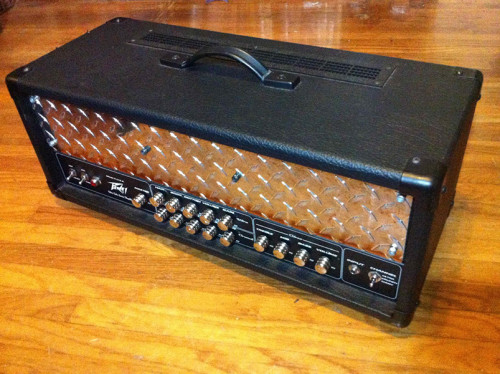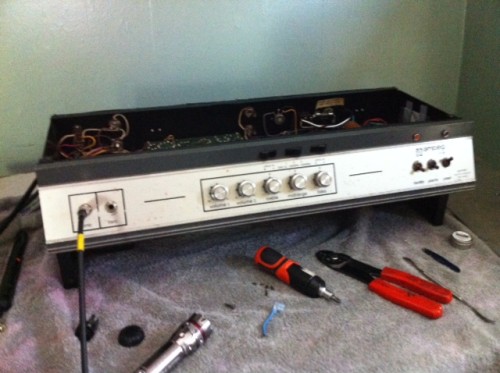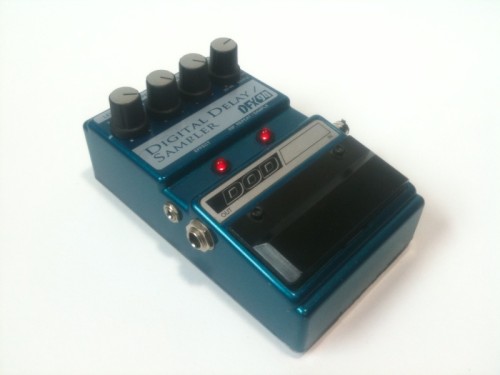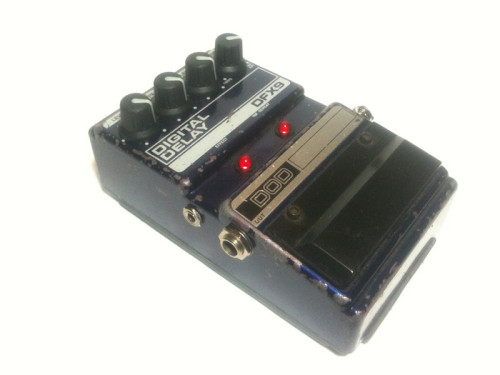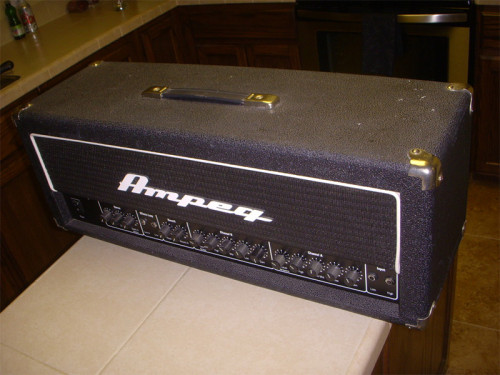Some people are simply amazing. And by amazing, I mean amazingly thick.
Here’s the story: Impaled drummer Raul called me from his work, Guitar Center. They were moving locations in the East Bay. They had a used Ampeg 1540HE cabinet they had sold and had been returned. Why? Because whomever sold this used item to Guitar Center did a real cracker-jacked job to fix it. Apparently, Guitar Center employees had never bothered to take off the grill before they bought it. One 10″ speaker and the 15″ speaker were replaced with car stereo sub woofers. WTF? They wanted it gone before they opened the store and let me have it for $50. What a mess. But I got it roaring again and looking okay.

The 1540HE is a fairly specialized cabinet. It’s designed to be paired with an Ampeg 400T rack mount amplifier or any amp that can do bi-amping (Ampeg 200T is another). What’s bi-amping you say? Basically, here you’ve got two cabs in one. The 400T is capable of running like two amps in one and splitting your signal between highs and lows. The theoretical use of the 1540HE is to send highs to the 10″ speakers, lows to the 15″ speakers, then blend and adjust until you get one bad-assed tone.
That’s the theory, anyway, so long as you know how to adjust one of these:
These cabs don’t have a lot of fans online and they weren’t produced for very long. Most numbnutted bass players just stuck an amp on top and plugged in, not accounting for bi-amping. It just doesn’t work as well, as the four 10″ speakers and the one 15″ speaker will not have the same presence from a single signal (say that three times fast). One can end up with weird phase cancellation of the actual sound coming out or just not get the full effect from the top or the bottom.
What really doesn’t make it sound good is when some dickbag puts in subwoofers meant for a car.
That is what I extracted from the cabinet. Speakerotomy. Luckily, I had a 15″ and a 10″ lying around that were perfect replacements. The 15″ I’d actually salvaged from a weird, fancy Hammond PR40 oak enclosure that someone had dumped in Oakland. I nabbed the only speaker left in it, and lo and behold, my pack-ratting paid off. The cab fired up fine and the speakers were all blaring.
A really bad design flaw on the 1540HE is the placement of a high frequency attenuator knob on the jack plate. It sticks out. Now, how many people do you know that load these refrigerator sized enclosures with grace? The damn shaft of the potentiometer had snapped in half. I pulled out the circuit board from the inside and went about figuring a solution.
Replacing this weird pot that had three switches was going to be a bitch. I tried the local moth ball electronics shop,
Al Lasher’s, but to no avail. They used to have a tube with set screws for such a problem, but not in 20 years. Instead, I made my own tube with some nylon washers and used 2 ton epoxy to set it.
I used a 1/4″ thick nylon bolt to extend the shaft of the pot. I got a nice set-screw knob from Al Lasher’s and the back plate was fixed. And ready to be broken again due to piss poor design!
The wood of the cabinet had itself taken a bit of beating. The majority of SLM made Ampeg cabs are comprised of particle board. That’s a far cry from the sturdy baltic birch the originals were constructed of. As soon as the cab starts taking hits from being loaded and unloaded, the edges start to fall apart. There’s really no excuse for this, other than planned obsolescence. I did my best to patch up some nasty wear on the corners where the metal plates had fallen off.
First, I filled in the original screw holes with some toothpicks covered in wood glue. Break these off, and you have a tight fit for a new screw where the old one have stripped out.
I mixed up some wood putty epoxy and molded myself new corners. It’s not as good as wood, but it’ll have to do for a patch up job.
I replaced the metal corners with some from another salvaged cabinet. These can also be ordered from one of my favorite sites,
Fliptops.net. They are the best source for Ampeg parts… much better than Ampeg the actual fucking company. The repair job looks rough, and fuck, it is. Short of rebuilding the entire enclosure, this band-aid is the best you can do for this kinda damage. Fuck particle board.
The tolex had a lot of rips. I put some more glue on these and then just taped it down and hoped for the best. Tolex is awesome and sucks all at the same time. It protects the wood, but when it rips, it’s over. The best is to just try and keep up with the rips as they happen. Cut off small pieces before they become big ones or glue ’em back down.
The casters also had to be replaced with correctly sized ones, not available at any store I’ve found. My only source is Fliptops. The ones the dildo before me had used lifted the cabinet a good 2″ off the ground. His solution? Nail a 2×4 board to the front of the cab. I had a salvaged (again) pair of casters that were Ampeg replacements. I bolted them in, ripped off the 2×4, and added a pair of the large rubber feet that are on all modern Ampeg bass cabs. Finally, I replaced the grill fasteners with some I had ordered awhile back, also from Fliptops. Put it all back together, and it ain’t too shabby.

Does that look okay? I hope so, because I plan on flipping this cabinet. I tried it, and for my money, I prefer a standard 8×10. Of course, like the numbnutted bassists I mentioned before, I’ve only played it with a non-biamp capable amplifier. Sure, it’s plenty loud, but it just didn’t have the same mids and follow-through punch I was used to getting so naturally from my other gear. Hopefully it makes someone else happy and my wallet a tad less skinny.
Doktor Ross Sewage
www.doktorsewage.com

